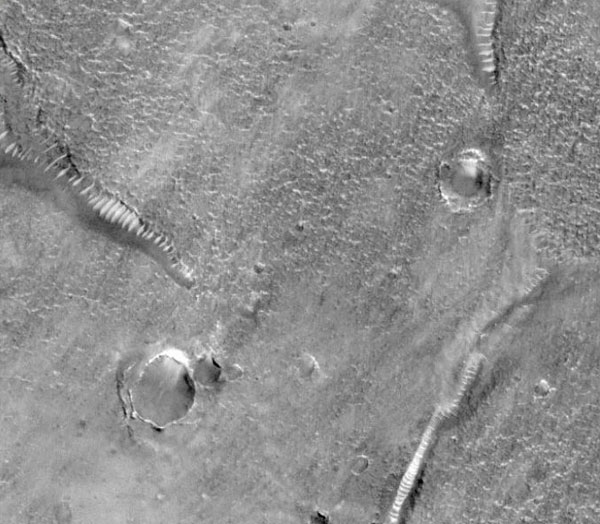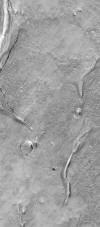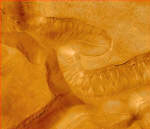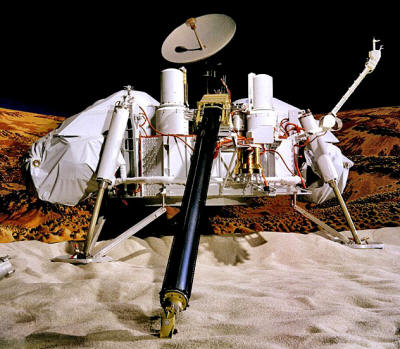On Mars Things Only Get More Weird
by David Talbott

Credit: NASA/JPL/Malin Space Science Systems
Mysterious domed
craters and trenches on Mars
point to electric discharge in recent geologic times.
In our Picture of the Day we compared photographs of small blue-gray spherules on Mars to the results of laboratory experiments by plasma physicist C J. Ransom. For his replication of these Martian “blueberries”, Ransom used a bed of hematite, a primary constituent of some Martian soils. By blasting the material with an electric arc, he produced an array of small blue-gray spherules and fused globules virtually identical in appearance to those seen on the surface of Mars.
Experiments of this sort will prove invaluable to our understanding of planetary evolution and geology. An electric arc is a plasma event, and plasma events are scalable, which means that the same formations can occur at virtually every scale—from centimeters-long sparks in laboratories to light years-long “jets” in active galaxies. Elementary structures of plasma discharge, now well documented in the laboratory, appear in lightning strikes, in auroras, on the Sun, in nebulas, and in remote galaxies.
The ease with which electric arcs create the Martian “blueberries” not only draws our attention to many apparent analogs on Earth, but to other larger scale formations on Mars. In our Picture of the Day for March 29 we showed images of a couple dozen “domed” craters on Mars, which have puzzled planetary scientists for several years. The spherical domes rest within circular craters and look very much like the spherules in Ransom’s experiments, which also rested in craters with partially fused rims.
On Mars the anomalous formations lie in the Arrhenius Region, some 36,000 square kilometer of terrain in the southern hemisphere east of Hellas Planitia. (More precisely, the region is located between 235° and 240° east longitude and 40° to 45° south latitude.) Planetary scientists have expressed their wonderment over these improbable formations while offering equally improbable guesses to account for them. A recent article published by R. Foxx, et al., listed five proposals, two of which (cinder cones and table mountains) they sought to substantiate as alternative possibilities, depending on when the domes were created in relation to the surface material in which they lie.

 There is more to this region than the domed craters, as can be seen in
the pictures above. We’ve placed a more complete picture of the region (click
image left). The weirdly “wormlike” formations, exposed within craggy
trenches, have provoked astonishment from scientists and a host of speculations
about “artificial tubes” or “transportation systems” beneath the
surface.
There is more to this region than the domed craters, as can be seen in
the pictures above. We’ve placed a more complete picture of the region (click
image left). The weirdly “wormlike” formations, exposed within craggy
trenches, have provoked astonishment from scientists and a host of speculations
about “artificial tubes” or “transportation systems” beneath the
surface.
In our Picture of the Day we compared photographs of small blue-gray spherules on Mars to the results of laboratory experiments by plasma physicist C J. Ransom. For his replication of these Martian “blueberries”, Ransom used a bed of hematite, a primary constituent of some Martian soils. By blasting the material with an electric arc, he produced an array of small blue-gray spherules and fused globules virtually identical in appearance to those seen on the surface of Mars.
Experiments of this sort will prove invaluable to our understanding of planetary evolution and geology. An electric arc is a plasma event, and plasma events are scalable, which means that the same formations can occur at virtually every scale—from centimeters-long sparks in laboratories to light years-long “jets” in active galaxies. Elementary structures of plasma discharge, now well documented in the laboratory, appear in lightning strikes, in auroras, on the Sun, in nebulas, and in remote galaxies.
The ease with which electric arcs create the Martian “blueberries” not only draws our attention to many apparent analogs on Earth, but to other larger scale formations on Mars. In our Picture of the Day for March 29 we showed images of a couple dozen “domed” craters on Mars, which have puzzled planetary scientists for several years. The spherical domes rest within circular craters and look very much like the spherules in Ransom’s experiments, which also rested in craters with partially fused rims.
On Mars the anomalous formations lie in the Arrhenius Region, some 36,000 square kilometer of terrain in the southern hemisphere east of Hellas Planitia. (More precisely, the region is located between 235° and 240° east longitude and 40° to 45° south latitude.) Planetary scientists have expressed their wonderment over these improbable formations while offering equally improbable guesses to account for them. A recent article published by R. Foxx, et al., listed five proposals, two of which (cinder cones and table mountains) they sought to substantiate as alternative possibilities, depending on when the domes were created in relation to the surface material in which they lie.

 There is more to this region than the domed craters, as can be seen in
the pictures above. We’ve placed a more complete picture of the region (click
image left). The weirdly “wormlike” formations, exposed within craggy
trenches, have provoked astonishment from scientists and a host of speculations
about “artificial tubes” or “transportation systems” beneath the
surface.
There is more to this region than the domed craters, as can be seen in
the pictures above. We’ve placed a more complete picture of the region (click
image left). The weirdly “wormlike” formations, exposed within craggy
trenches, have provoked astonishment from scientists and a host of speculations
about “artificial tubes” or “transportation systems” beneath the
surface.
But the speculations in the direction of
artificiality or intelligent construction can be excluded through consideration
of similarly grooved and ridged formations in other contexts such as the Gorgonum Region (click image
right), just one of thousands of examples.
Here, in brief, is an electrical interpretation. An interdisciplinary investigation of data concerning Mars suggests that in the past the entire planet was subjected to interplanetary-scale plasma discharge events.
Vast regions were excavated to depths
measured in miles. Some of the material was accelerated electrically into
space; some was emplaced back on the surface to form the ubiquitous but
unexpected layering, whose origin is now debated by planetary scientists.
Diffuse discharges baked the surfaces of implanted layers as in a plasma oven, giving rise to hardened strata exposed in the walls of canyons. Arc discharges burnt and blasted craters into the surface. Lightning many times more energetic than that of thunderstorms we know today ripped across the Martian landscape. Many of the blast channels it left are mistaken for flood or lava erosion, a perception that can be easily corrected through attention to detail.
But in the floors of many of these channels appear glassified ridges, or “fulgurites”, as in the Gorgonum Region noted above. On a smaller scale the lightning’s transverse coronal filaments, always perpendicular to the direction of the primary discharge, formed and fused the same characteristic ripples in the regolith of the Arrhenius Region. In some channels, multiple lightning strokes have cut terraces, each with its faint fulgurite ridges. The existence of these mysterious ridges is a crucial prediction of the Electric Universe.
In the electric view, therefore, both the domed craters and the accompanying trenches of the Arrhenius Region are the result of cosmic lightning strikes. Where an electric arc “stuck” briefly for a while to a point on the surface before being extinguished, it produced domed craters, as in Dr. Ransom’s experiments.
Diffuse discharges baked the surfaces of implanted layers as in a plasma oven, giving rise to hardened strata exposed in the walls of canyons. Arc discharges burnt and blasted craters into the surface. Lightning many times more energetic than that of thunderstorms we know today ripped across the Martian landscape. Many of the blast channels it left are mistaken for flood or lava erosion, a perception that can be easily corrected through attention to detail.
But in the floors of many of these channels appear glassified ridges, or “fulgurites”, as in the Gorgonum Region noted above. On a smaller scale the lightning’s transverse coronal filaments, always perpendicular to the direction of the primary discharge, formed and fused the same characteristic ripples in the regolith of the Arrhenius Region. In some channels, multiple lightning strokes have cut terraces, each with its faint fulgurite ridges. The existence of these mysterious ridges is a crucial prediction of the Electric Universe.
In the electric view, therefore, both the domed craters and the accompanying trenches of the Arrhenius Region are the result of cosmic lightning strikes. Where an electric arc “stuck” briefly for a while to a point on the surface before being extinguished, it produced domed craters, as in Dr. Ransom’s experiments.
Dr. Ransom has informed us that in his
experiments, if a lower energy arc was extinguished before a complete spherule
was formed, the result was a dome. The fully rounded spherules were the result
of higher-energy discharges. From the Electric Universe viewpoint, the domed
craters and the “wormy” channels simply reflect two common
electrical discharge effects on a surface.
We expect to find them in close
association.
And we can confidently predict that more
extensive laboratory experimentation will confirm the association in every
important detail.
from Thunderbolts
Website
via
http://www.bibliotecapleyades.net/electric_universe/esp_electricuniverse11.htm
It’s 99% Certain There is Life On
Mars
Soil samples from
Viking 1 Lander
which visited Mars in
1976
Mathematical analysis shows strong sign of organics Samples had been dismissed as contaminated '99% probability of life' claims one scientist |
by Rob Waugh
In July 1976, the Viking 1 probe touched down on Mars and failed to find traces of life - but now, three decades later,
scientists think the experiment was flawed.
VIking 1 did find evidence of extraterrestrial microbes in soil samples from the Red Planet.
Mathematical analysis of the samples concluded that salts in the soil on Mars 'threw off' initial estimates - and that the soil samples show strong evidence of microbial life.
The new analysis looked for 'complexity' in the samples - an indication of life.
VIking 1 did find evidence of extraterrestrial microbes in soil samples from the Red Planet.
Mathematical analysis of the samples concluded that salts in the soil on Mars 'threw off' initial estimates - and that the soil samples show strong evidence of microbial life.
The new analysis looked for 'complexity' in the samples - an indication of life.
To the surprise of the scientists, they
found it.
The Viking 1 lander which
arrived on Mars in July 1976.
Scientists now believe
there is strong evidence of microbial life in the soil samples analyzed by
Viking 1


Viking 1 launched by a Titan Centaur rocket
from Complex 41 at Cape
Canaveral Air Force Station
'This suggests a robust biological
response,' say the researchers, from the University of Siena and California's
Keck Institute.
'These analyses support the interpretation that the Viking LR experiment did detect extant microbial life on Mars.'
'These analyses support the interpretation that the Viking LR experiment did detect extant microbial life on Mars.'
The reassessment was prompted by the
discovery of 'perchlorates' in the soil at the
landing site of another Mars lander, Phoenix, in 2008.
The presence of the chemicals in Viking's samples had led scientists to conclude the samples were contaminated. The scientists behind the experiment remain divided over how conclusive the evidence for life on Mars is.
Christopher McKay of NASA's Ames Research Centre said, in an interview with Discovery News,
The presence of the chemicals in Viking's samples had led scientists to conclude the samples were contaminated. The scientists behind the experiment remain divided over how conclusive the evidence for life on Mars is.
Christopher McKay of NASA's Ames Research Centre said, in an interview with Discovery News,
'Finding organics is not evidence of life
or evidence of past life. It's just evidence for organics.'
'The ultimate proof is to take a video of a Martian bacteria. They should send a microscope - watch the bacteria move,' said Josheph Miller of USC's Keck School of Medicine.
'On the basis of what we've done so far, I'd say I'm 99 percent sure there's life there.'
'The ultimate proof is to take a video of a Martian bacteria. They should send a microscope - watch the bacteria move,' said Josheph Miller of USC's Keck School of Medicine.
'On the basis of what we've done so far, I'd say I'm 99 percent sure there's life there.'
Future Mars missions may be able to settle the question.
The Viking 1 lander on
display at the National Air and Space museum:
Did the craft discover
evidence of life on Mars?
a nuclear powered rover
vehicle
One forthcoming unmanned mission is the new
Mars Science Laboratory rover, called Curiosity, scheduled for launch in
November.
The $2.5 billion nuclear-powered machine will land on Mars' surface with a suite of 10 science instruments to try to determine if conditions are favorable for life.
Another key Mars mission is scheduled for 2016. Called the ExoMars Trace Gas Orbiter, it will carry five science instruments and will study gases in Mars' atmosphere, including methane, for evidence of biological or geological activity.
The $2.5 billion nuclear-powered machine will land on Mars' surface with a suite of 10 science instruments to try to determine if conditions are favorable for life.
Another key Mars mission is scheduled for 2016. Called the ExoMars Trace Gas Orbiter, it will carry five science instruments and will study gases in Mars' atmosphere, including methane, for evidence of biological or geological activity.
‘The instruments on that atmospheric
mission have a factor of 100 to 1,000 increase in sensitivity over what is
currently available from Mars orbiters or from ground observations,’ said Mark
Allen, Ph.D., who is the U.S. project scientist for the 2016 Mars mission.
from DailyMail Website via http://www.bibliotecapleyades.net/marte/marte_vida04.htm
For more information about Mars see http://nexusilluminati.blogspot.com/search/label/mars
For more information about plasma see http://nexusilluminati.blogspot.com/search/label/plasma
Help This Unique Independent Site
Survive
Donate any amount and receive at least one New Illuminati
eBook!
Just click in the jar -
For further
enlightening information enter a word or phrase into the search box @ New Illuminati or click on any label/tag at the
bottom of the page @ http://nexusilluminati.blogspot.com
And see
New Illuminati – http://nexusilluminati.blogspot.com
New Illuminati on Facebook - https://www.facebook.com/the.new.illuminati
New Illuminati Youtube
Channel - http://www.youtube.com/user/newilluminati/feed
The Her(m)etic Hermit -
http://hermetic.blog.com
The Prince of Centraxis - http://centraxis.blogspot.com
(Be Aware! This link leads
to implicate & xplicit concepts & images!)
This
site is published under Creative Commons Fair Use Copyright (unless an
individual item is declared otherwise by copyright holder) – reproduction for non-profit use is permitted & encouraged, if you give attribution to the work
& author - and please include a (preferably active) link to the original
along with this notice. Feel free to make non-commercial hard (printed) or
software copies or mirror sites - you never know how long something will stay
glued to the web – but remember attribution! If you like what you see, please
send a small but heartfelt donation or leave a comment – and thanks for reading
this far…
Live
long and prosper!
From the
New Illuminati – http://nexusilluminati.blogspot.com






No comments:
Post a Comment
Add your perspective to the conscious collective